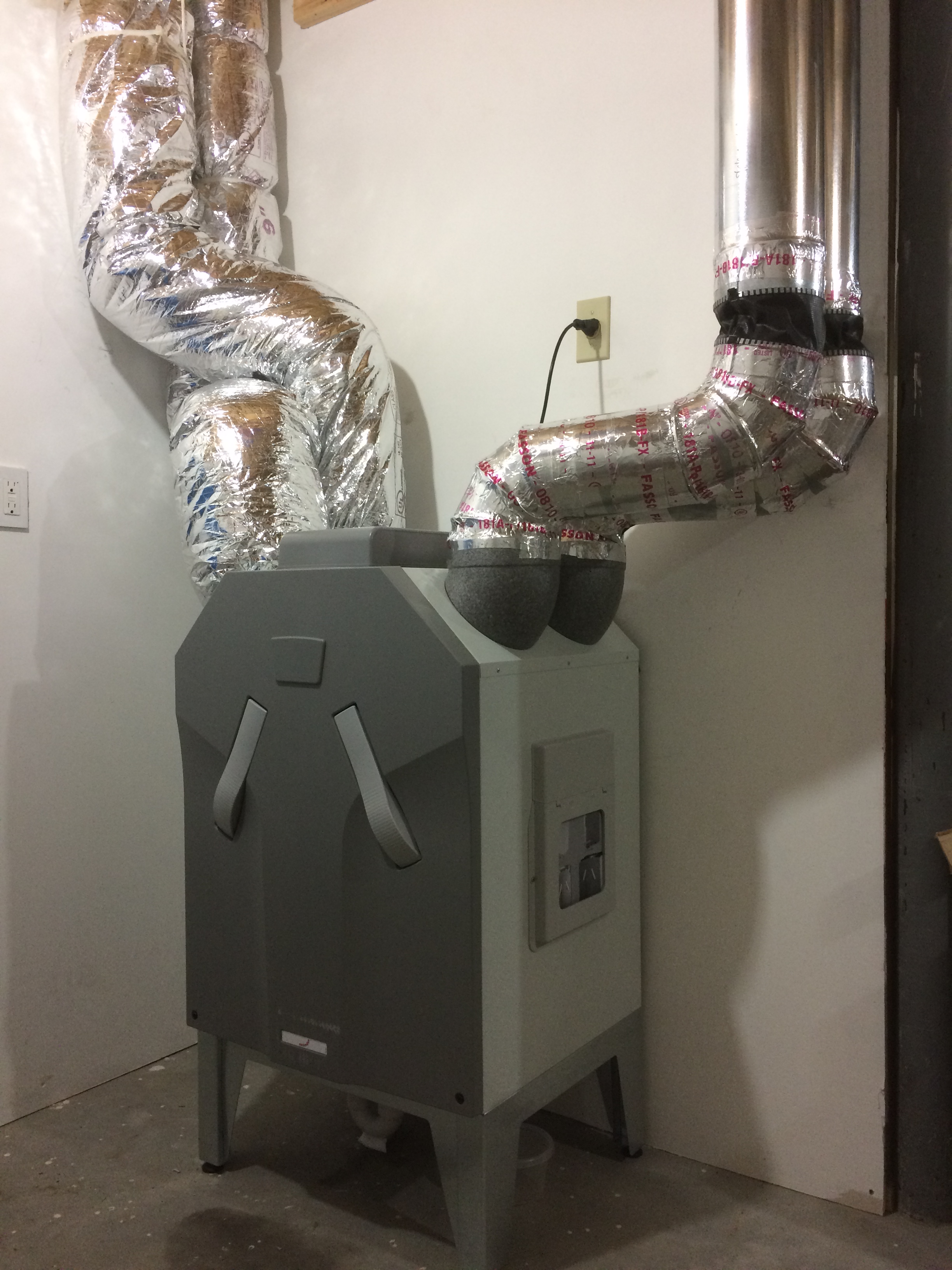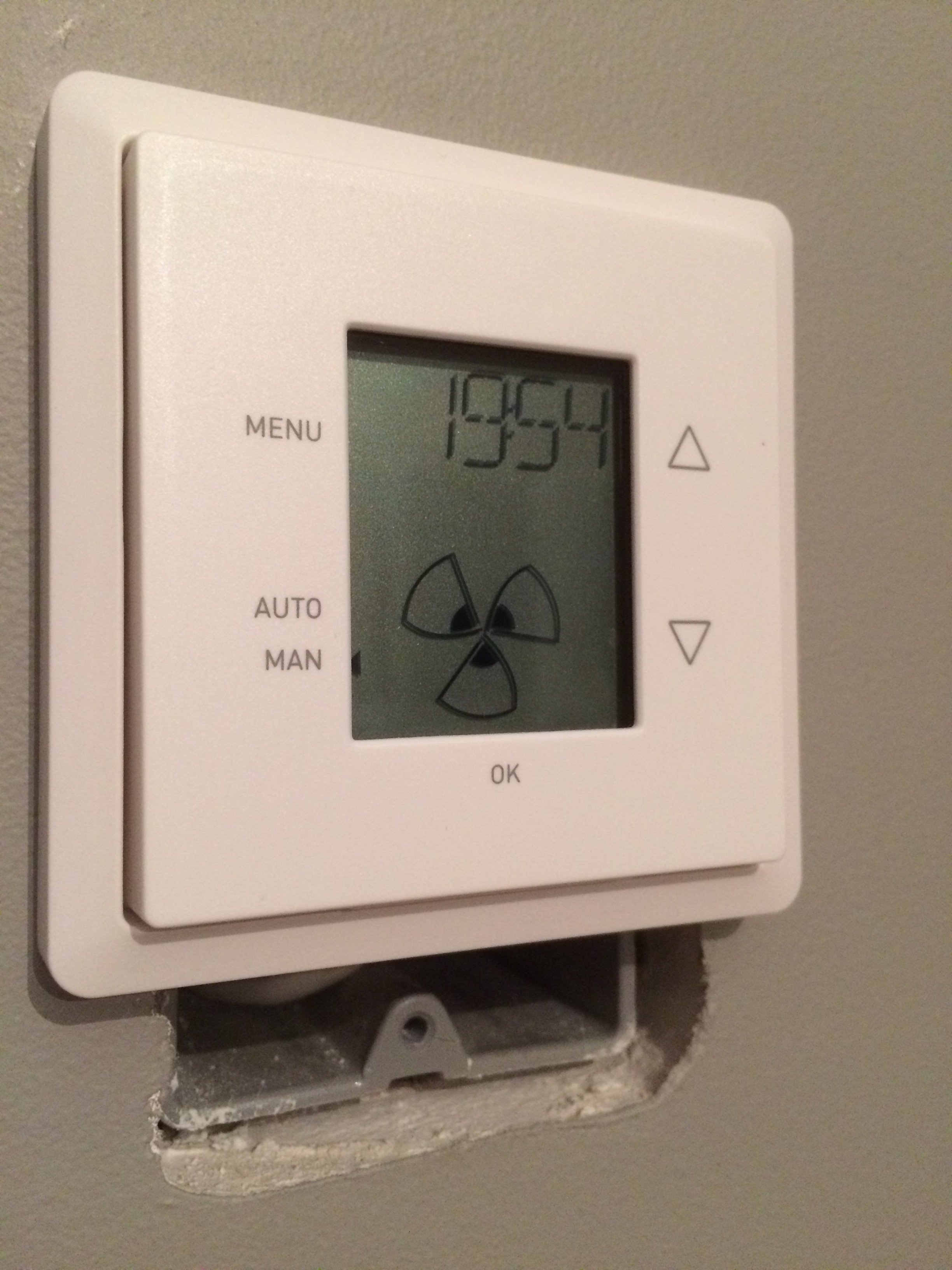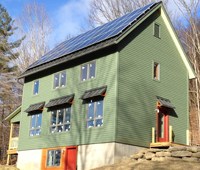Ventilator Retrofit

Last week our HVAC folks uninstalled our UltimateAir RecoupAerator ERV, and installed our new Zehnder HRV ComfoAir 350.
This is part 2 of our recent ventilator struggles. Read part 1, Problems persist with our UltimateAir ERV.
After the latest issues with our UltimateAir, I contacted Mike Duclos, our energy consultant, and asked his advice in selecting a new ventilator. Since the house was designed to use continuous ventilation at 60 CFM and a boost mode for removing extra moisture from the bathroom and odors from the kitchen, he recommended we give the Zehnder a closer look.
I knew a Zehnder would be expensive, so I asked about alternatives. Unfortunately, other options such as Venmar and RenewAire do not offer continuous ventilation at specific airflow rates. These units would have to cycle on and off to approximate our 60 CFM flow rate. These units would also require different vents to the outdoors that prevent backdraft cold air from entering the house when the unit is off.
The Zehnder can be set to specific air flow rates and run continuously. They also have a unit which is very similar in size and layout, so there’s not a lot of re-ducting required. The pre-heat is integrated inside the unit rather than separate, simplifying the install. We were able to easily convert the 2 circuits for the UltimateAir (one for the pre-heat and one for the ventilator) to one 15 amp 220 volt circuit for the Zehnder.
Zehnder offers both ERV and HRV models. When we were designing the house, we didn’t find any overwhelming rational for picking one type over the other. We went with the ERV because that is what UltimateAir made. We picked UltimateAir because it was energy efficient and being used in many new net zero homes.
But after almost 4 years of ERV use, we decided to try an HRV. We use the ventilator to vent the bathroom and kitchen. Sometimes the ERV was not able to do an adequate job of reducing the moisture in the air. Some humidity in the house is good in the winter, but when I started finding little patches of mold in the corners of the windows, I knew we had too much. Running the ERV in boost for longer periods of time did not seem to help.
Working with the folks at Zehnder was a pleasure. Within a week of asking for a quote, I had a new unit sitting in my basement.
We paid $1,329 in 2011 for the UltimateAir, not counting the preheater, controller, boost switches and installation. Over the next 4 years we paid just north of that in repairs. UltimateAir did offer us $400 toward the cost of the replacement unit. They have also offered to refund 50% of the original price upon return. I think we netted out spending roughly $2,400 without the refund, or 1,700 when the refund arrives.
The Zehnder unit came in at $2,300, plus installation (unknown at time of posting). After everything we’ve been through, it didn’t seem so expensive any more.
I’m quite happy with how easy and quickly they were able to swap out the units, less than 4 hours of work including commissioning.
If you notice in the picture at the top of the post, they had to swap the exterior air inlet and exhaust ducts. We also mounted the unit on the floor. They don’t recommend hanging them from the ceiling. Zehnder’s often have a large manifold mounted on top. They also don’t recommend hanging them on a wall that does not have a lot of density to muffle any vibrations. And because the unit is an HRV, it needs to be able to drain condensate, so there is a drain at the bottom. The new 220v outlet can also be seen behind the unit.


We were able to reuse the wiring from the unit to the control panel mounted on the first floor, although the control unit is a different size (not the standard US electrical outlet box size). This wouldn’t have been an issue if this was a fresh install. But since this is a retrofit, I now have to decide what to do with the mismatched control panel. I’m really surprised Zehnder US does not have a retrofit patch kit for this.
Likewise with the two boost switches in the bathroom and kitchen. Same sizing issue, although these switches are thinner and wireless which is totally awesome. No wires needed. And connecting them to the main control was easy.
Commissioning the unit was also a breeze. The UltimateAir required adjusting physical registers on the ventilator which required keen eyesight. The Zehnder is fully controlled from the control panel. The P-menu is a bit awkward, but fairly easy to figure out. I’m guessing in the not too distant future they will have an app for this. Seems silly to have wireless boost switches but I can’t use my phone to commission or make changes on the fly.
We’re using the low fan setting on manual mode for now. This fan speed delivers a continuous air flow rate of 100 meters cubed per hour or about 59 CFM if I’ve done my conversion correctly. At this speed the unit pulls about 23 to 24 watts. In boost mode it uses 102 watts.
Thus far, we’ve been using the new unit for about 11 days. In that time we’ve done a lot of Thanksgiving cooking, and friends have taken many showers. We’re very happy. Mainly it’s peace of mind. I have more confidence that the unit will just work. After all, it is the lungs of our house. You don’t want to worry about whether your lungs are working.
Happy Thanksgiving weekend!
- ERV: Energy Recovery Ventilator
- HRV: Heat Recovery Ventilator
- CFM: cubic feet per minute

Categories
- Air sealing 13
- Appliances & Fixtures 4
- Art 3
- Award 4
- Bathroom 8
- Batteries 1
- Decor 5
- Design 10
- Electrical 5
- Energy Calculations 13
- Energy Monitors 4
- Farm 1
- Finance 1
- Flooring 3
- Foundation 9
- Framing 8
- Heating 9
- House 7
- Insulation 8
- Kitchen 6
- Landscaping 3
- Lessons Learned 1
- Performance 60
- Plumbing 10
- Porch 5
- Radon 1
- Rainwater catchment 3
- Research / study 1
- Roof 7
- Septic / Waste water 2
- Sheetrock 6
- Siding 9
- Site Work 22
- Smart home 1
- Solar 64
- Solar Obsessed 10
- Stairs 2
- Surveying 3
- Ventilation 8
- Weather 1
- Windows & Doors 14
- plug-in 3
Archive
- Jan 2021 1
- Dec 2020 2
- May 2020 1
- Jan 2020 1
- May 2019 1
- Jan 2019 3
- Sep 2018 2
- Aug 2018 2
- Jan 2018 1
- Oct 2017 2
- Apr 2017 1
- Jan 2017 1
- Oct 2016 2
- Aug 2016 1
- Apr 2016 2
- Jan 2016 2
- Nov 2015 2
- Oct 2015 1
- Jul 2015 1
- May 2015 1
- Apr 2015 1
- Jan 2015 1
- Dec 2014 1
- Nov 2014 2
- Oct 2014 4
- Sep 2014 2
- Aug 2014 1
- Jul 2014 1
- Mar 2014 3
- Feb 2014 2
- Jan 2014 2
- Nov 2013 1
- Oct 2013 1
- Sep 2013 1
- Jul 2013 3
- Apr 2013 3
- Jan 2013 3
- Dec 2012 2
- Nov 2012 3
- Oct 2012 1
- Sep 2012 3
- Aug 2012 3
- Jul 2012 2
- Jun 2012 1
- May 2012 3
- Apr 2012 2
- Mar 2012 4
- Feb 2012 4
- Jan 2012 5
- Dec 2011 4
- Nov 2011 9
- Oct 2011 10
- Sep 2011 9
- Aug 2011 6
- Jul 2011 6
- Jun 2011 12
- May 2011 8
- Apr 2011 4
- Mar 2011 5
- Jan 2011 6
- Dec 2010 9
- Nov 2010 3
- Oct 2010 4
- Sep 2010 6
- Aug 2010 8
- Jul 2010 6
- Jun 2010 3
- May 2010 3
- Apr 2010 1
- Mar 2010 3
- Feb 2010 3
- Dec 2009 1
- Jun 2009 1
- May 2009 1
- Feb 2009 1
- Dec 2008 1
- Nov 2008 1
- Jun 2008 1
